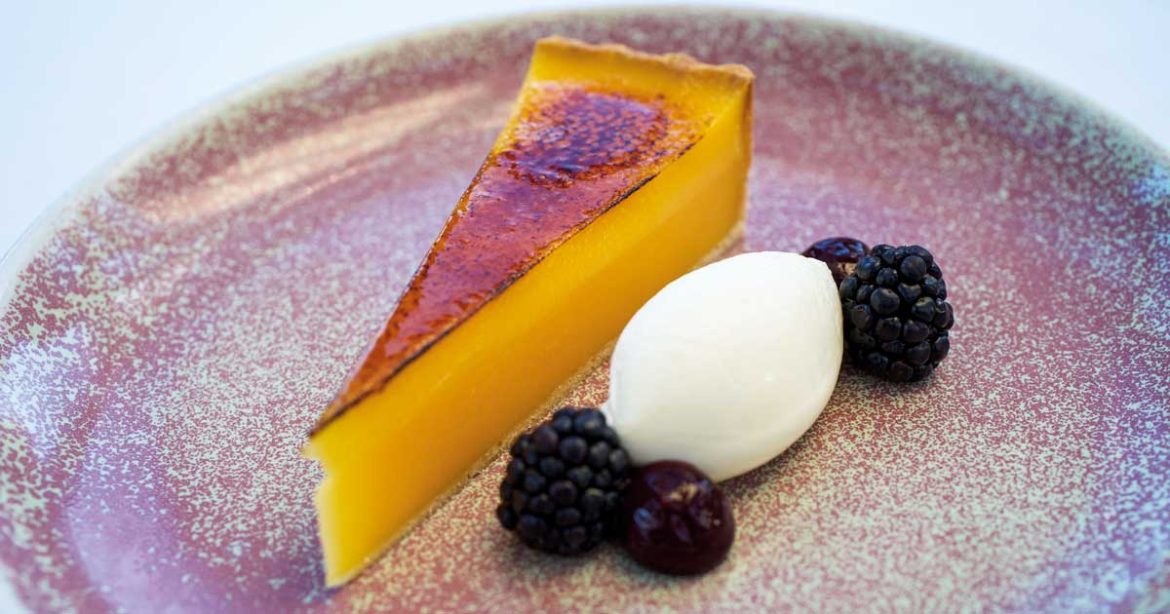Titchwell Manor’s new head chef, Oliver Bacon-Hilton, takes us through a pair of simple, but delicious classics
Famous for its seafood and fabulous local produce, north Norfolk has a reputation as one of the UK’s foodie hotspots. As well as an abundance of great ingredients from land and sea, its 45 miles of stunning coastline offers restaurants and gastropubs galore, but despite stiff competition in all directions, the charming Titchwell Manor stands out as one of the county jewels.
A refashioned Victorian farmhouse on Titchwell Marsh, this Brancaster hotel and restaurant is run by the Snaith family, with Margaret and Ian opening doors in the late 80s, and son Eric (also patron of Eric’s Fish and Chips) taking the reins a few years back. The latest addition to the team is head chef Oliver Bacon-Hilton, who honed his skills at Michelin-starred restaurants including Moor Hall in Aughton, Lancashire; and Morston Hall in Holt, Norfolk. He’s hoping to build on the restaurant’s excellent reputation, combining showstopping local ingredients with cutting-edge techniques to cement its place on the county’s dining map.
“I was drawn to Titchwell Manor as I’m from Norfolk, and it’s an established hotel in the area I’ve always wanted to be part of,” he explains. “My approach is classics done well. Good food and fantastic flavours with amazing produce cooked beautifully, that guests want to come back for!”
On the menu, find delicious local seafood dishes like dressed Brancaster crab, as well as luxurious fine-dining fare such as Creedy Carver duck breast, served with duck leg sausage and ‘pommes anna’ (layered potatoes cooked in an indecent amount of melted butter). Oliver confesses to having a sweet tooth, and his passion for pud shines through with some gorgeous desserts, including tiramisu millefeuille with coffee-infused caramel and custard. One of his go-to bakes is a chocolate brownie, but the pièce de résistance? “Definitely lemon tart. I love it!” he enthuses. “It sounds simple, but executed well there isn’t anything better.”
Find Oliver’s recipe for lemon tart, as well as a savoury favourite, below.
Lemon tart
Zingy citrus, creamy custard and delicate pastry make this dessert a sure-fire winner
For the sweet pastry
- 250g plain flour
- 100g unsalted butter
- 100g icing sugar
- 2 medium eggs
- Small pinch of salt
- 2 egg yolks for brushing
Step-by-Step Guide
1. Rub the flour and butter together with your fingers until you get breadcrumbs.
2. Sieve the icing sugar and mix into the flour and butter.
3. Beat eggs and salt together, then, with a wooden spoon or spatula, mix the eggs with the breadcrumb mixture to bind it.
4. Tip the bowl out onto a lightly floured surface and knead the dough for 30 seconds – being careful
not to overwork it.
5. Flatten the dough slightly – this way, when you come to roll it out, it won’t crack and will be easier to work with. Place in cling film and refrigerate for one hour, leaving to rest.
For the lemon tart mix
- 7 medium eggs
- 275g caster sugar
- 230ml double cream
- 4 lemons, juice and zest
Step-by-Step Guide
1. Whisk everything together and leave for two minutes. Then, with a small ladle or spoon, skim the pale layer of the mixture off the top.
2. Place in the fridge: this is best left for at least 12 hours before using.
Baking the tart
1. Preheat the oven to 170°C.
2. Roll out your sweet pastry dough on a lightly floured surface, to roughly the thickness of a pound coin.
3. Place into your desired tart case, making sure to press into all the corners.
4. Lay a sheet of greaseproof paper into your tart case and add baking beans, then bake for ten to 12 minutes.
5. In a pan, gently heat the lemon tart mixture to no more than ‘blood temperature’ (37°C), while your case is baking. Strain the mixture through a sieve into a pouring jug, to remove the lemon zest and any bits that remain in the mix.
6. Remove the case from the oven, then take out the baking beans and parchment paper, and place back in the oven. Cook the bottom of the base for a further three minutes. This will prevent a soggy bottom!
7. Turn the oven to 110°C.
8. Beat your egg yolks, take the tart case out of the oven again and egg wash it. This will help to seal it and prevent any spillage in the oven. Place it back in for another two minutes. Then, repeat this process one further time.
9. Pour your strained, warm lemon tart mixture into the baked tart case.
10. Make sure the oven is on a low temperature and there’s no residual heat left in the oven. Gently close the door and bake your tart for around 35-45 minutes, or until – when you shake the tart – it’s no longer liquid.
11. Leave to cool down and set to one side. Trim the tart so it will come away from the case (for this, I like to use a vegetable peeler).
Cured salmon

This dish is perfect for dinner parties – or to store in the fridge as a deluxe sandwich filler!
Ingredients
- 250g table salt
- 250g caster sugar
- 500g salmon fillet
Optional
- 1 raw beetroot, grated
- 2 tbsp fennel seeds
- 1 bunch of fresh dill
- 1 shot of gin (your choice)
Step-by-Step Guide
1. De-skin the salmon fillet and take out any pin bones (your fishmonger should happily do this, if asked). Score four times, so the cure penetrates the fish all the way through.
2. Combine the salt and sugar and mix with a whisk, so it’s an even consistency.
3. At this stage, include any optional extras: for beetroot flavour, combine it with the salt and sugar. For gin-cured salmon, mix the gin with the salt and sugar to create a texture like wet sand. Or, blend the dill and fennel seeds for a lovely aniseed flavour, and incorporate that into your cure.
4. Spread half of your desired salt-and-sugar mix evenly in a tray, and lay the scored salmon on top of this.
5. Then, evenly spread the remainder of the mix, making sure to cover the edges and sides of the fish.
6. Cover with cling film and leave in the fridge for 24 hours to make the fish firm.
7. Wash the salmon off under cold water, removing all salt, and pat with a dry cloth or clean tea towel.
8. To serve, cut into thin and even slices.
For more foodie heaven, check out February’s Food News here.

